Orthopedic surgeons now using robotic-assisted platform to more precisely align implants

If anyone needed a perfect knee replacement, it’s Nicole Showell, 53, of Clayton.
As a full-time caregiver for her mother-in-law, Zelma, she navigates stairs several times a day in their two-story Glen Laurel home, delivering medications, meals and other care. So when she fell and injured an arthritic knee, she wondered how she was going to manage.
To her advantage, Showell had already lost weight by faithfully following a healthful diet and exercise plan. And while cortisone injections helped ease her knee pain, they lost their effectiveness over time.
So Showell chose surgery, and she became the first patient at UNC Health Johnston to undergo a knee replacement using CORI, a robotic-assisted platform. Her orthopedic surgeon, Dr. Karl Bowman, used the handheld robotic device to create a 3D model of her knee, planning the implant size, position and alignment.
“Using technology allows us to much more accurately match the position of the knee replacement to the patient's ligaments and tendons,” Dr. Bowman says. “The goal is to achieve a 'balanced’ knee.
“To achieve a long-lasting and pain-free joint replacement, the soft-tissue tension around the knee has to be symmetric through the full knee range of motion,” he says. “That way the implant works with the patient's own tissues instead of fighting against them.”
Dr. Bowman began using robotics about seven years ago. At the time, the implementation of robotic surgery was becoming more mainstream, he adds. “But the startup costs to hospitals were daunting.”
When he moved back home to North Carolina, he was able to use a robotic platform at a surgery center he joined. “Once I discovered the power of using computerized navigation in joint replacement, I quickly adopted the technology for all of my joint replacements,” he said.
While knee arthritis has been common for decades, Dr. Bowman says the advances in joint replacement have expanded the surgical offering to younger people. Thus far, his youngest patient has been 38.
“Now that we have greater than 20 years of data on the longevity of knee replacement, most surgeons are willing to offer this treatment to a younger age,” he says.
Showell says she was surprised and delighted to be the first. “I’m doing well and pleased to be back to my routine,” she says.
Since Showell’s surgery in March, all orthopedic surgeons at UNC Health Johnston have taken the training and are now using CORI for knee and some hip replacement surgeries.
“We’re pleased to invest in technology that improves outcomes for joint replacement patients,” says Leigh Anne Bartlett, director of surgical services.